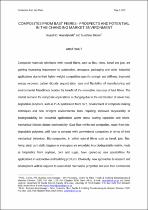 ResearchSpace
ResearchSpace
Composites from bast fibres - prospects and potential in the changing market environment
JavaScript is disabled for your browser. Some features of this site may not work without it.
- ResearchSpace
- →
- Research Publications/Outputs
- →
- Conference Publications
- →
- View Item
| dc.contributor.author |
Anandjiwala, RD

|
|
| dc.contributor.author |
Blouw, S

|
|
| dc.date.accessioned | 2009-03-06T12:10:44Z | |
| dc.date.available | 2009-03-06T12:10:44Z | |
| dc.date.issued | 2004-10 | |
| dc.identifier.citation | Anandjiwala, RD and Blouw, S. 2004. Composites from bast fibres - prospects and potential in the changing market environment. FAO Global Workshop: Bast Fibrous Plants for Healthy Life, Banja Luka, Bosnia-Herzegovina, 24-28 October, pp 22. | en |
| dc.identifier.uri | http://hdl.handle.net/10204/3157 | |
| dc.description | FAO Global Workshop: Bast Fibrous Plants for Healthy Life, Banja Luka, Bosnia-Herzegovina, 24-28 October 2004 | en |
| dc.description.abstract | Composite materials reinforced with natural fibres, such as flax, hemp, kenaf and jute, are gaining increasing importance in automotive, aerospace, packaging and other industrial applications due to their lighter weight, competitive specific strength and stiffness, improved energy recovery, carbon dioxide sequestration, ease and flexibility of manufacturing and environmental friendliness besides the benefit of the renewable sources of bast fibres. The market scenario for composite applications is changing due to the introduction of newer biodegradable polymers such as PLA synthesized from corn, development of composite making techniques and new stringent environmental laws requiring improved recyclability or biodegradability for industrial applications where stress bearing capacities and micro-mechanical failures dictate serviceability. Bast fibre reinforced composites, made from biodegradable polymer, will have to compete with conventional composites in terms of their mechanical behaviour. Bio-composites, in which natural fibres such as kenaf, jute, flax, hemp, sisal, corn stalk, bagasse or even grass are embedded in a biodegradable matrix, made as bioplastics from soybean, corn and sugar, have opened up new possibilities for applications in automotive and building projects. Obviously new approaches to research and development will be required to assess their mechanical properties and also their commercial competitiveness against petroleum based products. This paper will review the newer products and techniques that can improve the properties of bast fibre based composites as well as potential applications which can increase their market share | en |
| dc.language.iso | en | en |
| dc.subject | Fibre-reinforced composites | en |
| dc.subject | Biodegradable | en |
| dc.subject | Natural fibres | en |
| dc.subject | Bast fibres | en |
| dc.subject | Hemp | en |
| dc.subject | Flax | en |
| dc.subject | Kenaf | en |
| dc.subject | Particle boards | en |
| dc.subject | Automotive components | en |
| dc.subject | Biocomposites | en |
| dc.subject | Thermoset | en |
| dc.subject | Thermoplastics | en |
| dc.subject | FAO Global Workshop 2004 | en |
| dc.title | Composites from bast fibres - prospects and potential in the changing market environment | en |
| dc.type | Conference Presentation | en |
| dc.identifier.apacitation | Anandjiwala, R., & Blouw, S. (2004). Composites from bast fibres - prospects and potential in the changing market environment. http://hdl.handle.net/10204/3157 | en_ZA |
| dc.identifier.chicagocitation | Anandjiwala, RD, and S Blouw. "Composites from bast fibres - prospects and potential in the changing market environment." (2004): http://hdl.handle.net/10204/3157 | en_ZA |
| dc.identifier.vancouvercitation | Anandjiwala R, Blouw S, Composites from bast fibres - prospects and potential in the changing market environment; 2004. http://hdl.handle.net/10204/3157 . | en_ZA |
| dc.identifier.ris | TY - Conference Presentation AU - Anandjiwala, RD AU - Blouw, S AB - Composite materials reinforced with natural fibres, such as flax, hemp, kenaf and jute, are gaining increasing importance in automotive, aerospace, packaging and other industrial applications due to their lighter weight, competitive specific strength and stiffness, improved energy recovery, carbon dioxide sequestration, ease and flexibility of manufacturing and environmental friendliness besides the benefit of the renewable sources of bast fibres. The market scenario for composite applications is changing due to the introduction of newer biodegradable polymers such as PLA synthesized from corn, development of composite making techniques and new stringent environmental laws requiring improved recyclability or biodegradability for industrial applications where stress bearing capacities and micro-mechanical failures dictate serviceability. Bast fibre reinforced composites, made from biodegradable polymer, will have to compete with conventional composites in terms of their mechanical behaviour. Bio-composites, in which natural fibres such as kenaf, jute, flax, hemp, sisal, corn stalk, bagasse or even grass are embedded in a biodegradable matrix, made as bioplastics from soybean, corn and sugar, have opened up new possibilities for applications in automotive and building projects. Obviously new approaches to research and development will be required to assess their mechanical properties and also their commercial competitiveness against petroleum based products. This paper will review the newer products and techniques that can improve the properties of bast fibre based composites as well as potential applications which can increase their market share DA - 2004-10 DB - ResearchSpace DP - CSIR KW - Fibre-reinforced composites KW - Biodegradable KW - Natural fibres KW - Bast fibres KW - Hemp KW - Flax KW - Kenaf KW - Particle boards KW - Automotive components KW - Biocomposites KW - Thermoset KW - Thermoplastics KW - FAO Global Workshop 2004 LK - https://researchspace.csir.co.za PY - 2004 T1 - Composites from bast fibres - prospects and potential in the changing market environment TI - Composites from bast fibres - prospects and potential in the changing market environment UR - http://hdl.handle.net/10204/3157 ER - | en_ZA |





